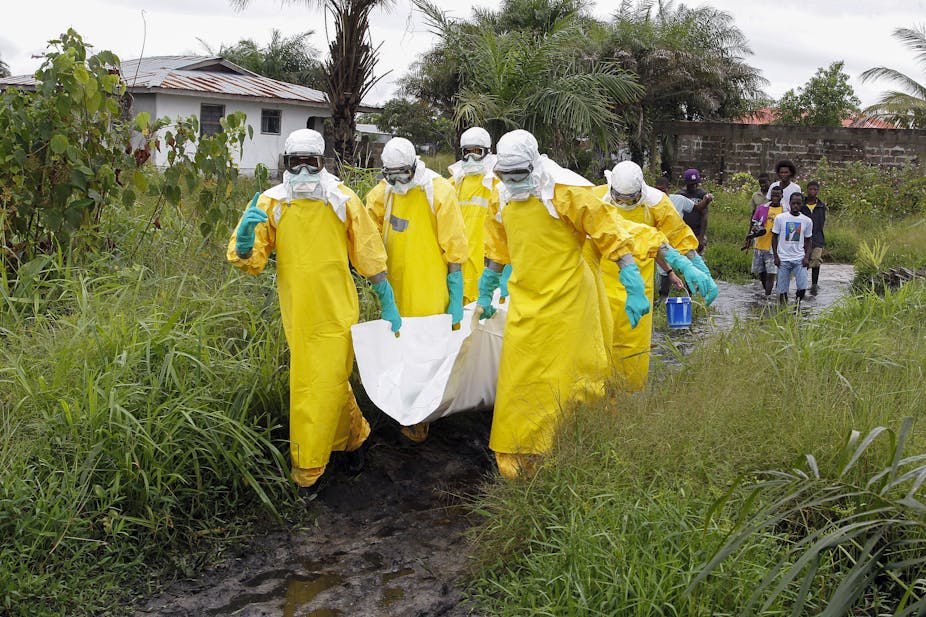Since August last year the Democratic Republic of Congo (DRC) has been facing its 10th Ebola virus disease outbreak. As of early March this year, 907 cases and 569 deaths have been reported.
The virus seems to be gaining ground in this current outbreak in North Kivu. This despite extensive control measures being put in place. These were sufficient to end the 9th outbreak region of Equateur, 2500km from North Kivu.
Part of the response has been to try out new drug regimes. As such, research is playing a critical role as efforts are made to establish their efficacy. But testing new vaccines is an arduous and time consuming process. It’s also hard in the case of Ebola because there are a few different strains of the virus.
In the race between research and Ebola, a vaccine candidate made by Merck is being tested. It’s part of new strategies implemented to limit the number of deaths.
The vaccine was inherited from the West African Ebola outbreak between 2014 and 2016 when there were 28,600 cases and 11,325 deaths. The severity of the outbreak led the international community to vow that it would never happen again.
The question is: why, despite the vaccine trials, as well as a range of other interventions, does the outbreak remain out of control in North Kivu?
Factors contributing to this include violence in the region during the recent presidential election. Unrest in North Kivu led to the destruction of an Ebola Transit Center earlier this month in Katwa. Then at the end of February two more centres were burnt to the ground in Katwa and Butembo. On top of this, armed rebel groups in the area are limiting people’s access and hampering the response.
These challenges highlight the impact the community has on the success or failure of the Ebola response.
Breaking new ground
The Merck vaccine that’s being used in the DRC has gone through several research studies. But it’s still not licensed and can’t be used in the same way as any other vaccines.
The vaccine is being used on a compassionate basis to protect those most at risk of infection. This use of the vaccine requires that patients give informed consent, that data on safety including severe side effects be collected after every vaccine. This is not the case for licensed vaccines used in mass campaign vaccination.
Since May 2018 more than 40,000 people have received Merck’s rVSV vaccine in Equateur and North Kivu. The rollout has been a joint effort run by, among others, the Ministry of Health, Institut National de Recherche Biomédicale, World Health Organisation (WHO) and Medécins Sans Frontieres.
Early data suggests that the vaccine is contributing to limiting the spread of the outbreak.
Other treatment options are also being tested alongside the vaccine. People who manage to get to an Ebola treatment centre and who test positive for the disease now have the opportunity to receive four new treatments being tried out. This is part of a clinical trial – the first of its kind – assessing the efficacy of these treatments. One of them was developed from the blood of a survivor of the 1995 Ebola outbreak in Kikwit, DRC.
The efficacy of the new drugs will be assessed by comparing the number of deaths in each of the four treatments groups after 28 days.
In all Ebola treatments centres, confirmed Ebola patients are asked if they want to participate. One of the drugs is then randomly selected and given to the patient who is followed for 58 days. Since 27th November 2018, 62 patients have participated in the trial. However the study is currently on hold due to the recent attacks.
As the virus is moving faster than the response, another vaccine will soon be evaluated in Uganda by a consortium including the London School of Hygiene and Tropical Medicine, Uganda Virus Research Institute, and Epicentre.
Developed by Janssen Pharmaceutical, this works differently to the Merck vaccine. Results so far show that it can provide protection for one year and could be used in areas not yet affected by Ebola (preventively). For its part, rVSV could be used reactively – that is in response to contacts of confirmed cases.
The Janssen vaccine targets Ebola Zaire, and when used with a booster 56 days after the first dose, it also targets Ebola Sudan, Ebola Bundibugyo and Marburg virus which have caused outbreaks in neighbouring Uganda and Sudan. The design of this new study is not yet finalised. But we believe that the 2 million courses of the vaccine that are available could play their part in the race between research and the Ebola virus.
In Uganda 800 health care and frontline workers will receive the first dose of the vaccine followed by a second dose 56 days later. They will be followed for two years.
It will take many years for the successful vaccines and drugs to be licensed. But, if they prove effective, they will improve responses to any new Ebola outbreaks.
The end game
The hope is that, by the end of the current outbreak, the world will be better equipped to prevent, treat and stop Ebola virus disease. But science will win the race against Ebola virus only if communities are fully part of the response. Getting a deeper understanding of how people respond to crises such as Ebola will require others, such as anthropologists, to get involved too.

